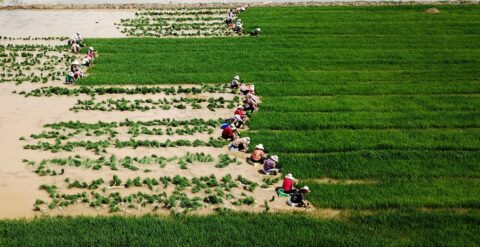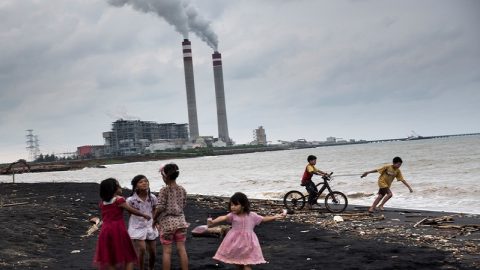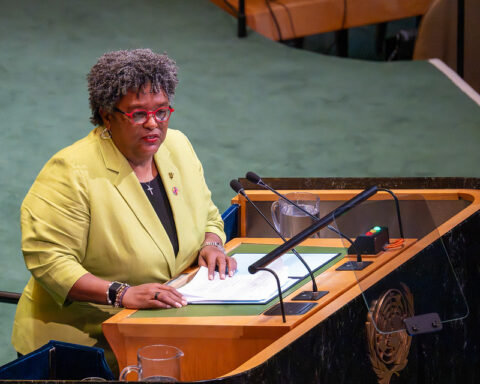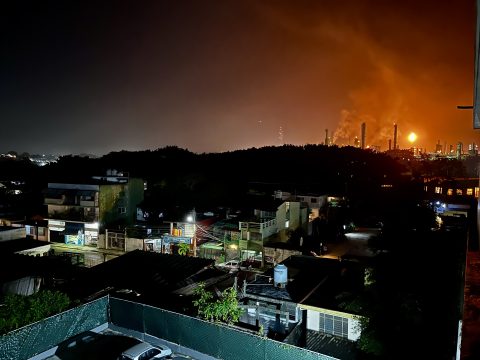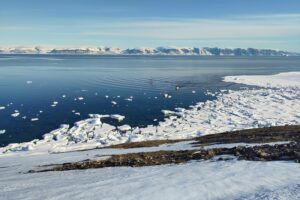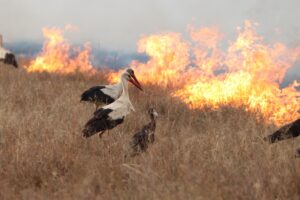The livestock industry is essential for food security and economic development, according to a draft report by the United Nations’ Food and Agricultural Organization (FAO) that reinforces its defence of practices in the emissions-heavy sector in recent years.
Former and current FAO officials and academics have criticised the document, seen by Climate Home News, for pro-industry bias, cherry-picking data and even “disinformation” about the environmental impacts of animal farming.
The FAO told Climate Home that a final version of the report – part of an assessment consisting of various documents – would be launched in 2025 and that conclusions should not be drawn from the draft text at this stage.
Estimates of livestock’s contribution to greenhouse gas emissions vary, ranging from 12%-20% of the global total – mostly in the form of methane from ruminants like cows and sheep, and carbon dioxide (CO2) released when forests are cut down for pasture.
Methane, which is emitted in cow burps and manure, is a short-lived greenhouse gas that is 84 times more potent than CO2 over 20 years, making it one of the few available levers to prevent climate tipping points being reached in the near term.
In a 2024 survey of more than 200 scientists and sustainable agriculture experts, about 78% said livestock numbers should peak globally by 2025 to start bringing down emissions and help keep global warming to internationally agreed limits.
But the FAO’s draft study offers strong support for growth of the sector, saying livestock’s contributions to food security, nutrition and raw materials for industry make it a “linchpin for human well-being and economic development”.
It is also described as “critical” for food security, “crucial” for global economies, and “indispensable” for development in sub-Saharan Africa.
The report will be submitted to the FAO’s agriculture committee, which has 130 member nations, although the text could change as national representatives thrash out a final version.
Private-sector lobbyists participating as advisors in national delegations are sometimes also able to influence texts under discussion, according to a July report by the Changing Markets Foundation.
One FAO insider, who did not want to be named, told Climate Home the draft FAO report had been “biased towards pushing livestock [with] many national interests behind it”.
The FAO receives around a third of its budget in direct donations from member countries, and the rest in voluntary contributions from the same states and other actors, including businesses and trade associations.
Tech fixes
The 491-page draft report, which was overseen by a scientific advisory committee of 23 experts and peer reviewers, does not assess how diets with more plant protein could improve food security.
One advisory committee member, Professor Frederic Leroy of Vrije Universiteit Brussel, told Climate Home a shift to entirely plant-based diets “would severely compromise the potential for food security worldwide because many of the food nutrients which are already limited in global diets are found in livestock. How much you can move (away from livestock) should be the real investigation.”

This table from a World Bank report (Recipe for a Livable Planet), published in May 2024, shows that vegan diets are the lowest in emissions (Screenshot/World Bank)
The report’s analysis assumes rising meat production as demand surges among a growing world population with higher incomes. In this context, it proposes “expanding the (livestock) herd size”, increasing production through intensified systems, better use of genetic techniques, and improved land management.
“Technological innovations” such as feed additives and supplements to suppress methane are another idea backed by the FAO. Those could include experimental methods such as a vaccine announced last week and funded by a $9-million grant from the Bezos Earth Fund that aims to reduce the number and activity of methane-producing microbes in a cow’s stomach.

Herdsman Musa takes cattle to graze along the Dodowa-Somenya road in Ghana, April 12, 2024. According to environmentalist Kwame Ansah, ‘The unchecked grazing is not only destroying crops but also eroding soil fertility exacerbating land degradation.’ (Photo: Matrix Images/Christian Thompson/via Reuters)
The report’s findings, once approved, will be fed into a three-part roadmap for bringing agricultural emissions in line with the Paris Agreement goal of limiting global warming to 1.5 degrees Celsius.
The first instalment, published at the COP28 climate summit, was viewed internally by some FAO experts as a generic placeholder which largely followed an industry-friendly agenda.
One ex-FAO official, who requested anonymity, told Climate Home the latest draft report on livestock ploughs a similar furrow and would set expectations for part two of the 1.5C roadmap.
“The reality is that if they do a (nearly) 500-page report and put 23 experts’ names in front of it, it’s to impress you and say: ‘This is what is going to happen. We’re going to defend the sector’,” the former UN official said.
Making the case for meat
The expert added that the study’s panel was skewed toward intensified livestock systems and had “cherry picked” evidence to justify recommendations pointing in that direction.
Several of the report’s advisory committee members have previously advocated for meat-based diets, and 11 of the study’s contributors work for the International Livestock Research Institute (ILRI), including one of the paper’s committee advisors.
According to the ex-FAO official, ILRI “has been pushing intensified livestock all its life. It’s their identity. It’s what they do.”
The institute co-founded an agribusiness-backed initiative – Pathways to Dairy Net Zero (P2DNZ) – which de-emphasised livestock emissions, framing them as just one of several problems for the industry to tackle.
ILRI did not respond to a request for comment.
IPCC’s input into key UN climate review at risk as countries clash over timeline
Shelby C. McClelland, of New York University’s Center for Environmental and Animal Protection, told Climate Home she was shocked by a repeated claim in the draft FAO report of “a lack of consensus among scientists regarding the contribution of livestock to global greenhouse gas emissions”.
“This downplays and outright ignores overwhelming scientific evidence from the IPCC [Intergovernmental Panel on Climate Change], high-profile papers, and other recent studies,” McClelland said. “A statement like this in a supposedly scientific and evidenced-based review by the UN FAO is alarming given their influence on agenda-setting for global climate action.”
Advisory committee member Leroy countered that it was “dangerous” to talk about a scientific consensus when the metrics used to measure methane compared to other greenhouse gases are constantly evolving.
“This should be part of an open and transparent debate,” he added. “I don’t think we have reached consensus on the way we interpret the effects of livestock agriculture on climate change, the degree of it, how we can measure it and how we can deal with it.”
Scientists at the FAO first alerted the world to the meat industry’s climate footprint when they attributed 18% of global emissions to livestock farming in the seminal 2006 study, Livestock’s Long Shadow. This analysis found that, far from enhancing food security, “livestock actually detract more from total food supply than they provide.”
However, the paper sparked a backlash felt by key experts in the agency’s Rome headquarters, as the FAO hierarchy, industry lobbyists and state donors to its biannual $1-billion budget exerted pressure for a change of direction.
By the time of last December’s COP28, the FAO’s stance had shifted so far that two experts cited in another livestock emissions study called publicly for its retraction. They argued it had distorted their work and underestimated the emissions reduction potential from farming less livestock by a factor of between 6 and 40.

A deforested and burnt area is seen in an indigenous area used as cattle pasture in Areoes, Mato Grosso state, Brazil, September 4, 2019. (Photo: REUTERS/Lucas Landau)
No ‘carte blanche’
Guy Pe’er, a conservation ecologist at the German Centre for Integrative Biodiversity Research and the Helmholtz Centre for Environmental Research, accused the FAO of turning a blind eye to widespread “hyper-intensive grazing practices” and land use change caused by the world’s growing number of mega-farms.
“We’re currently using more land to feed livestock than humans, and that is causing rapid deforestation in Brazil. Ignoring that is outrageous. When an official organisation is producing disinformation like this, I find it extremely irresponsible,” he said.
Leroy told Climate Home that different types of livestock farming should not be conflated. “If you have over-grazing and the pollution of water sources, that’s clearly wrong, but other types of animal agriculture are also net-positive [for the environment],” he said.
If the advisory committee “sees advantages in having livestock agriculture as part of the food system, I think there’s a sound scientific basis to assume that,” he added. “It doesn’t mean that it’s carte blanche or ‘anything goes’ at all.”
(Reporting by Arthur Neslen; editing by Megan Rowling and Joe Lo)
The post FAO draft report backs growth of livestock industry despite emissions appeared first on Climate Home News.
FAO draft report backs growth of livestock industry despite emissions
Climate Change
DeBriefed 19 December 2025: EU’s petrol car U-turn; Trump to axe ‘leading’ research lab; What climate scientists are reading
Welcome to Carbon Brief’s DeBriefed.
An essential guide to the week’s key developments relating to climate change.
This week
EU easing up
HITTING THE BREAKS: The EU “walked back” its target to ban the sale of petrol and diesel cars by 2035, “permitting some new combustion engine cars”, reported Agence-France Presse. Under the original plan, the bloc would have had to cut emissions entirely by 2035 on new vehicles, but will now only have to cut emissions by 90% by that date, compared to 2021 levels. However, according to the Financial Times, some car manufacturers have “soured” on the reversal.
ADJUSTING CBAM: Meanwhile, the Financial Times reported that the EU is making plans to “close loopholes” in the bloc’s carbon border adjustment mechanism (CBAM) before it goes into effect in January. CBAM is set to be the world’s first carbon border tax and has drawn ire from key trading partners. The EU has also finalised a plan to delay its anti-deforestation legislation for another year, according to Carbon Pulse.
Around the world
- NCAR NO MORE: The Trump administration is moving to “dismantle” the National Center for Atmospheric Research in Colorado, said USA Today, describing it as “one of the world’s leading climate research labs”.
- DEADLY FLOODS: The deadliest flash flooding in Morocco in a decade killed “at least” 37 people, while residents accused the government of “ignoring known flood risks and failing to maintain basic infrastructure”, reported Radio France Internationale.
- FAILING GRADE: The past year was the “warmest and wettest” ever recorded in the Arctic, with implications for “global sea level rise, weather patterns and commercial fisheries”, according to the US National Oceanic and Atmospheric Administration’s 2025 Arctic report card, covered by NPR.
- POWER TO THE PEOPLE: Reuters reported that Kenya signed a $311m agreement with an African infrastructure fund and India’s Power Grid Corporation for the “construction of two high-voltage electricity transmission lines” that could provide power for millions of people.
- BP’S NEW EXEC: BP has appointed Woodside Energy Group’s Meg O’Neill as its new chief executive amid a “renewed push to…double down on oil and gas after retreating from an ambitious renewables strategy”, said Reuters.
29
The number of consecutive years in which the Greenland ice sheet has experienced “continuous annual ice loss”, according to a Carbon Brief guest post.
Latest climate research
- Up to 4,000 glaciers could “disappear” per year during “peak glacier extinction”, projected to occur sometime between 2041 and 2055 | Nature Climate Change
- The rate of sea level rise across the coastal US doubled over the past century | AGU Advances
- Repression and criminalisation of climate and environmentally focused protests are a “global phenomena”, according to an analysis of 14 countries | Environmental Politics
(For more, see Carbon Brief’s in-depth daily summaries of the top climate news stories on Monday, Tuesday, Wednesday, Thursday and Friday.)
Captured

The latest coal market report from the International Energy Agency said that global coal use will reach record levels in 2025, but will decline by the end of the decade. Carbon Brief analysis of the report found that projected coal use in China for 2027 has been revised downwards by 127m tonnes, compared to the projection from the 2024 report – “more than cancelling out the effects of the Trump administration’s coal-friendly policies in the US”.
Spotlight
What climate scientists are curious about
This week, Carbon Brief spoke to climate scientists attending the annual meeting of the American Geophysical Union in New Orleans, Louisiana, about the most interesting research papers they read this year.
Their answers have been lightly edited for length and clarity.
Dr Christopher Callahan, assistant professor at Indiana University Bloomington
The most interesting research paper I read was a simple thought experiment asking when we would have known humans were changing the climate if we had always had perfect observations. The authors show that we could have detected a human influence on the climate as early as the 1880s, since we have a strong physical understanding of how those changes should look. This paper both highlights that we have been discernibly changing the climate for centuries and emphasises the importance of the modern climate observing network – a network that is currently threatened by budget cuts and staff shortages.
Prof Lucy Hutyra, distinguished professor at Boston University
The most interesting paper I read was in Nature Climate Change, where the researchers looked at how much mortality was associated with cold weather versus hot weather events and found that many more people died during cold weather events. Then, they estimated how much of a protective factor in the urban heat island is on those winter deaths and suggested that the winter benefits exceed the summer risks of mitigating extreme heat, so perhaps we shouldn’t mitigate extreme heat in cities.
This paper got me in a tizzy…It spurred an exciting new line of research. We’ll be publishing a response to this paper in 2026. I’m not sure their conclusion was correct, but it raised really excellent questions.
Dr Kristina Dahl, vice president for science at Climate Central
This year was when we saw source attribution studies, such as Chris Callahan‘s, really start to break through and be able to connect the emissions of specific emitters…to the impact of those emissions through heat or some other sort of damage function. [This] is really game-changing.
What [Callahan’s] paper showed is that the emissions of individual companies have an impact on extreme heat, which then has an impact on the GDP of the countries experiencing that extreme heat. And so, for the first time, you can really say: “Company X caused this condition which then led to this economic damage.”
Dr Antonia Hadjimichael, assistant professor at Pennsylvania State University
It was about interdisciplinary work – not that anything in it is ground-shakingly new, but it was a good conversation around interdisciplinary teams and what makes them work and what doesn’t make them work. And what I really liked about it is that they really emphasise the role of a connector – the scientist that navigates this space in between and makes sure that the things kind of glue together…The reason I really like this paper is that we don’t value those scientists in academia, in traditional metrics that we have.
Dr Santiago Botía, researcher at Max Planck Institute for Biogeochemistry
The most interesting paper I’ve read this year was about how soil fertility and water table depth control the response to drought in the Amazon. They found very nicely how the proximity to soil water controls the anomalies in gross primary productivity in the Amazon. And, with that methodology, they could explain the response of recent droughts and the “greening” of the forest during drought, which is kind of a counterintuitive [phenomenon], but it was very interesting.
Dr Gregory Johnson, affiliate professor at the University of Washington
This article explores the response of a fairly coarse spatial resolution climate model…to a scenario in which atmospheric CO2 is increased at 1% a year to doubling and then CO2 is more gradually removed from the atmosphere…[It finds] a large release of heat from the Southern Ocean, with substantial regional – and even global – climate impacts. I find this work interesting because it reminds us of the important – and potentially nonlinear – roles that changing ocean circulation and water properties play in modulating our climate.
Cecilia Keating also contributed to this spotlight.
Watch, read, listen
METHANE MATTERS: In the Guardian, Barbados prime minister Mia Mottley wrote that the world must “urgently target methane” to avoid the worst impacts of climate change.
CLIMATE WRAPPED: Grist summarised the major stories for Earth’s climate in 2025 – “the good, the bad and the ugly”.
COASTING: On the Coastal Call podcast, a biogeochemist spoke about “coastal change and community resilience” in the eastern US’s Long Island Sound.
Coming up
- 27 December: Cote D’Ivoire parliamentary elections
- 28 December: Central African Republic presidential and parliamentary elections
- 28 December: Guinean presidential election
Pick of the jobs
- BirdLife International, forest programme administrator | Salary: £28,000-£30,000. Location: Cambridge, UK
- World Resources Institute, power-sector transition senior manager | Salary: $116,000-$139,000. Location: Washington DC
- Fauna & Flora, operations lead for Liberia | Salary: $61,910. Location: Monrovia, Liberia
DeBriefed is edited by Daisy Dunne. Please send any tips or feedback to debriefed@carbonbrief.org.
This is an online version of Carbon Brief’s weekly DeBriefed email newsletter. Subscribe for free here.
The post DeBriefed 19 December 2025: EU’s petrol car U-turn; Trump to axe ‘leading’ research lab; What climate scientists are reading appeared first on Carbon Brief.
Climate Change
Recent COP hosts Brazil and Azerbaijan linked to “super-emitting” methane plumes
As countries come under growing pressure to tackle planet-heating methane emissions from the fossil fuel sector, oil and gas producers in COP host nations Brazil and Azerbaijan are struggling to prevent large leaks of methane, data shared with Climate Home News shows.
Satellite observations detected “super-emitting” methane plumes in the two countries this year that were visible from space and linked to state oil companies in both cases. Brazil presided over this year’s COP30 climate talks, while COP29 was in Azerbaijan.
Methane is a greenhouse gas that traps about 80 times more heat in the atmosphere than carbon dioxide but has a shorter life span. If global warming is to stay below 1.5C, the International Energy Agency (IEA) estimates that methane emissions from fossil fuels would need to fall by 75% by 2030.
At COP26 in 2021, a group of more than 100 countries announced their intention to cut methane emissions across all sectors by 30% from 2020 levels by the end of this decade. But a UN Environment Programme (UNEP) assessment shows they are instead set to rise 5% by 2030.
At COP30 this November, Brazil’s Environment Minister Marina Silva said that reducing methane emissions “gives us an opportunity to keep the planet’s average temperature [rise] within 1.5C, decreasing the frequency, intensity and impact of extreme weather events and protecting lives”.
And last year, Rovshan Najaf, president of Azerbaijan’s state oil company SOCAR, promised that the firm would achieve near-zero methane emissions in its oil and gas production by 2035.
However, the latest data available from Azerbaijan’s SOCAR shows that the company’s methane emissions more than tripled from 2023 to 2024, when the country hosted COP29. SOCAR identified about 200,000 tonnes of methane emissions from its business activities in 2024.
Brazilian state-oil company Petrobras, meanwhile, did manage to reduce its methane emissions by more than half between 2015 and 2022, but they have since stayed stagnant, at about a million tonnes of CO2-equivalent emitted per year, the company’s annual sustainability data shows.
“Reducing methane has significant impacts on a country’s ability to meet its climate commitments,” said Tengi George-Ikoli, a methane expert with the National Resource Governance Institute (NRGI).
“Countries like Brazil and Azerbaijan, who have hosted COPs, should be seen to commit to those efforts more so than others,” she emphasised.
In 2025, UNEP’s International Methane Emissions Observatory (IMEO) alerted countries globally – including Brazil and Azerbaijan – to around 2,200 instances linking their oil and gas production to super-emitting events.
Both Brazil and Azerbaijan have focal points that receive these IMEO alerts. But a recent report shows that 90% of the notifications did not even receive a response, and neither Brazil nor Azerbaijan are listed in the 25 successful cases that managed to reduce emissions thanks to this system.
Big plumes in Azerbaijan’s southern oil & gas hub
In Azerbaijan, persistent large-scale methane emissions have been detected over its southern coast – a hub for its oil and gas industry – during the past two years, according to satellite data from online monitoring platform Carbon Mapper.
When satellites passed over the region in mid-2024, as Azerbaijan prepared to host the COP29 climate summit, they spotted a handful of massive methane plumes, each releasing between 2,000 and 4,000 kilogrammes of methane per hour, dozens of times above the threshold for a “super-emitting” event.
According to Carbon Mapper’s data, methane emissions from the same locations still persisted a year later at comparable or even higher levels.

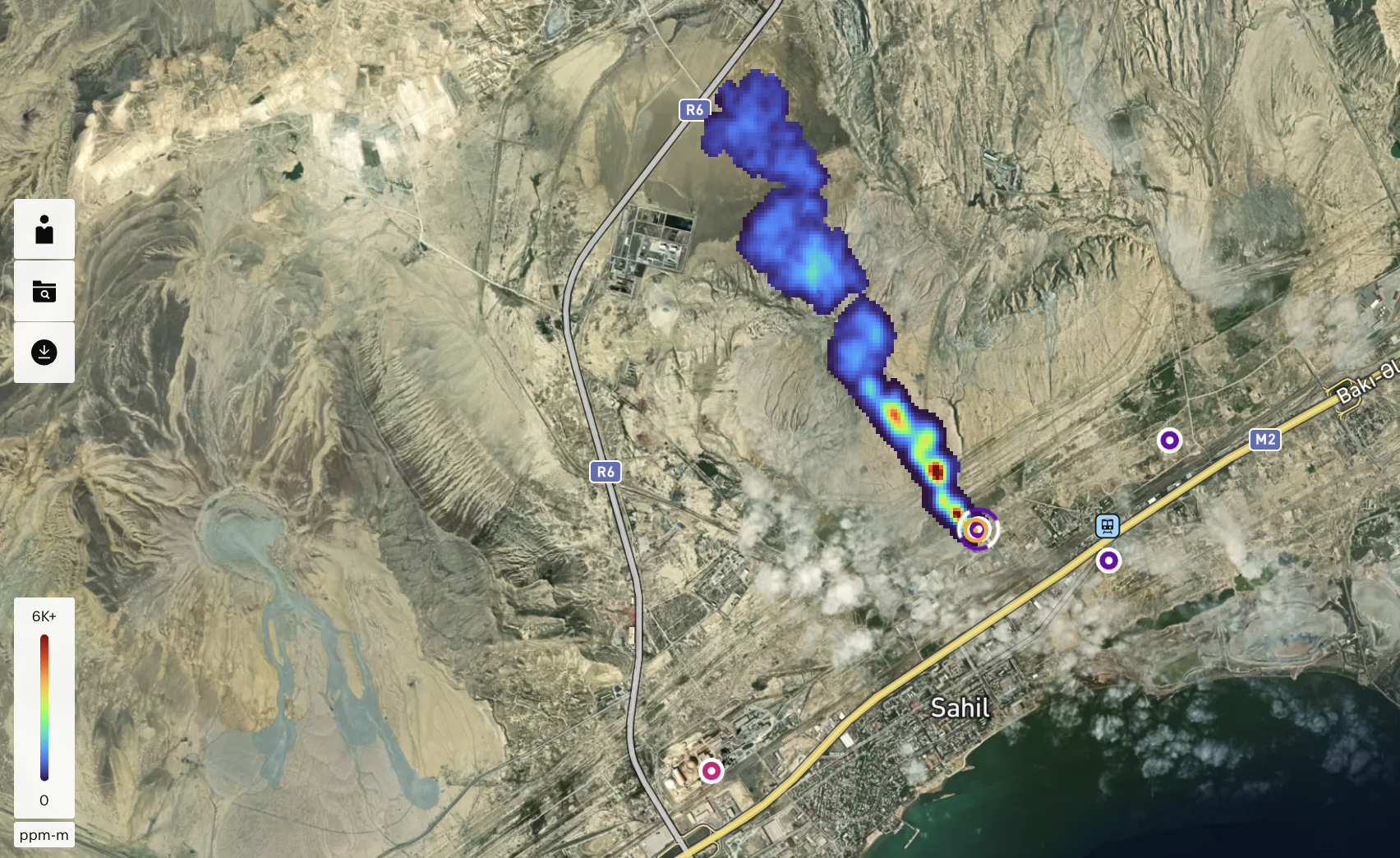


It is impossible to pinpoint precisely the source of those emissions without ground-level monitoring. But satellite data suggests that methane was released both from pipelines – which may be leaking – and compressor stations, which are facilities that help keep fossil gas flowing by boosting its pressure.
Throughout this year, large methane plumes have been observed by satellites emanating from a facility run by SOCAR in one of the world’s oldest oil fields, located just a few miles from Baku’s swanky waterfront boulevard.
In its 2025 sustainability report, SOCAR said it had expanded its methane emissions monitoring by using “leak detection AI tools”, drones and satellite technologies that “enabled more targeted, data-driven responses and supported the development of effective mitigation measures across operational sites”.
State oil firm in COP30 host nation linked to leaks
In Brazil, state-oil company Petrobras has been linked to three methane “super-emitting events” detected by satellites this year, which raises questions about emissions from its offshore oil and gas production facilities.
Three large methane plumes were detected in the Santos basin off the coast of Rio de Janeiro – which holds several of Brazil’s largest oil and gas fields – by Carbon Mapper on April 23.
Further analysis by environmental nonprofit SkyTruth, which specialises in satellite observations, revealed the plumes came from vessels in the Tupi field, which is majority-owned by Petrobras. Two of the vessels are operated by Dutch company SBM and the other by Petrobras.
The plumes in the Santos basin were large enough to be considered “super-emitting” methane events, on a scale similar to leaks in the same category detected in other parts of the world.
The US Environmental Protection Agency defines these as events with a rate of emissions of 100 kg of methane per hour. Two of the plumes detected in Brazil were above 300 and one was above 700 kg of methane per hour.
The events in Brazil are “particularly stunning” and could point to a more persistent issue, SkyTruth’s CEO John Amos told Climate Home, because the three plumes were detected during just one observation by a satellite orbiting the area.
“For one attempt to produce three positive plumes suggests that this could be a systematic problem offshore,” he said.
Petrobras says mitigation measures in place
Asked about these cases, Petrobras told Climate Home in a statement that the company is committed to reducing methane emissions as part of its decarbonisation strategy. It added that, because the plumes were detected by a single satellite observation, “the ability to draw broader conclusions about the consistency and magnitude of emissions over time is limited”.
The company also highlighted that its assets in the Santos basin perform “within the industry’s first quartile” for emissions per barrel of oil and noted that “initiatives such as recovering flare gas and performing leak detection and repair campaigns have helped to mitigate methane emissions”.
Petrobras also said that “during the period in question, operational conditions were under normal circumstances”.
Amos argued that if the sector considers such super-emitter plumes of methane – observable from space – “to be a consequence of ‘normal operating conditions’, then the offshore methane problem may be far worse than we anticipated”.
Just days before COP30, Petrobras executives co-chaired an offshore oil and gas conference in Rio de Janeiro. The discussions, the organisers wrote in a welcome letter, would focus on “traditional oil and gas technologies while highlighting the innovations essential for a more sustainable future” and would be “strategically positioned amid the ongoing energy transition”.
Barbados PM proposes binding methane pact
As global greenhouse gas emissions have continued to rise, with the United Nations admitting in November that an overshoot of the 1.5C warming limit is now inevitable, action on methane garnered growing attention at COP30.
New initiatives were launched at the climate summit in Belém to tackle methane emissions from the production of fossil fuels, which accounts for about a third of global emissions from this “super pollutant”, with other key sources being agriculture and waste management.
The UK launched a declaration to “drastically reduce” methane from the fossil fuel sector, which was endorsed by 11 countries including major oil and gas producers Canada, Norway and Kazakhstan. The actions it supports include more transparent monitoring, eliminating routine flaring and venting, and tracking progress towards near-zero methane emissions per unit of production.
The UK and Brazil also launched a three-year $25-million funding package to help developing countries tackle methane, among other “super pollutant” gases, which will benefit a first cohort of mostly fossil fuel-producing countries – among them Brazil, Kazakhstan, Mexico and Nigeria.
At last year’s COP29, the European Union championed an initiative that encouraged fossil fuel-producing countries to create roadmaps towards abating methane emissions from coal, oil and gas, including timelines, investment needs and the amount of emissions to be abated.
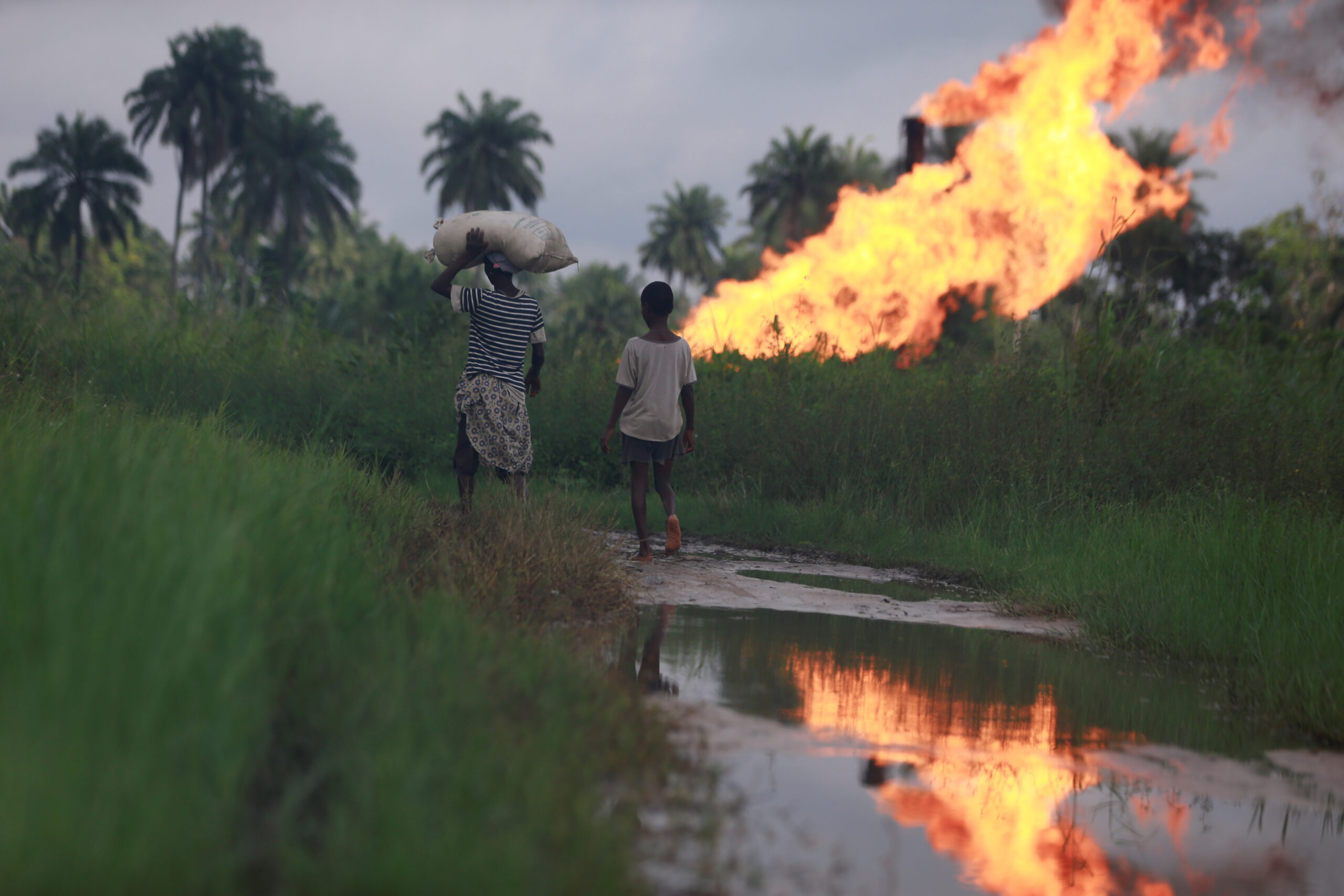

But, as a growing clutch of voluntary initiatives has failed to produce results at the scale and speed needed to rein in global warming in the short term, pressure is rising for a more accountable and comprehensive approach to the problem.
At COP30, Barbados’ Prime Minister Mia Mottley renewed her call for a legally binding methane pact to “pull the methane emergency brake” and “buy us some time”, starting with actions in the oil and gas industry.
NRGI’s George-Ikoli said the oil and gas sector could lead on cutting methane emissions because measures like zero flaring and venting, and eliminating leaks could bring in revenues for companies by enabling them to use or sell currently wasted gas.
Mottley wrote in an op-ed for The Guardian this month that the next step would be to convene heads of state from willing nations to develop “a roadmap in 2026 for binding measures for the oil and gas industry”. Negotiations could start by 2027, with a deal adopted “as soon as possible thereafter”, she proposed.
The post Recent COP hosts Brazil and Azerbaijan linked to “super-emitting” methane plumes appeared first on Climate Home News.
Recent COP hosts Brazil and Azerbaijan linked to “super-emitting” methane plumes
Climate Change
Guest post: How to steer EVs towards the road of ‘mass adoption’
Electric vehicles (EVs) now account for more than one-in-four car sales around the world, but the next phase is likely to depend on government action – not just technological change.
That is the conclusion of a new report from the Centre for Net Zero, the Rocky Mountain Institute and the University of Oxford’s Environmental Change Institute.
Our report shows that falling battery costs, expanding supply chains and targeted policy will continue to play important roles in shifting EVs into the mass market.
However, these are incremental changes and EV adoption could stall without efforts to ensure they are affordable to buy, to boost charging infrastructure and to integrate them into power grids.
Moreover, emerging tax and regulatory changes could actively discourage the shift to EVs, despite their benefits for carbon dioxide (CO2) emissions, air quality and running costs.
This article sets out the key findings of the new report, including a proposed policy framework that could keep the EV transition on track.
A global tipping point
Technology transformations are rarely linear, as small changes in cost, infrastructure or policy can lead to outsized progress – or equally large reversals.
The adoption of new technologies tends to follow a similar pathway, often described by an “S-curve”. This is divided into distinct phases, from early uptake, with rapid growth from very low levels, through to mass adoption and, ultimately, market saturation.
However, technologies that depend on infrastructure display powerful “path-dependency”, meaning decisions and processes made early within the rollout can lock in rapid growth, but equally, stagnation can also become entrenched, too.
EVs are now moving beyond the early-adopter phase and beginning to enter mass diffusion. There are nearly 60m on the road today, according to the International Energy Agency, up from just 1.2m a decade ago.
Technological shifts of this scale can unfold faster than expected. Early in the last century in the US, for example, millions of horses and mules virtually disappeared from roads in under three decades, as shown in the chart below left.
Yet the pace of these shifts is not fixed and depends on the underlying technology, economics, societal norms and the extent of government support for change. Faster or slower pathways for EV adoption are illustrated in the chart below right.
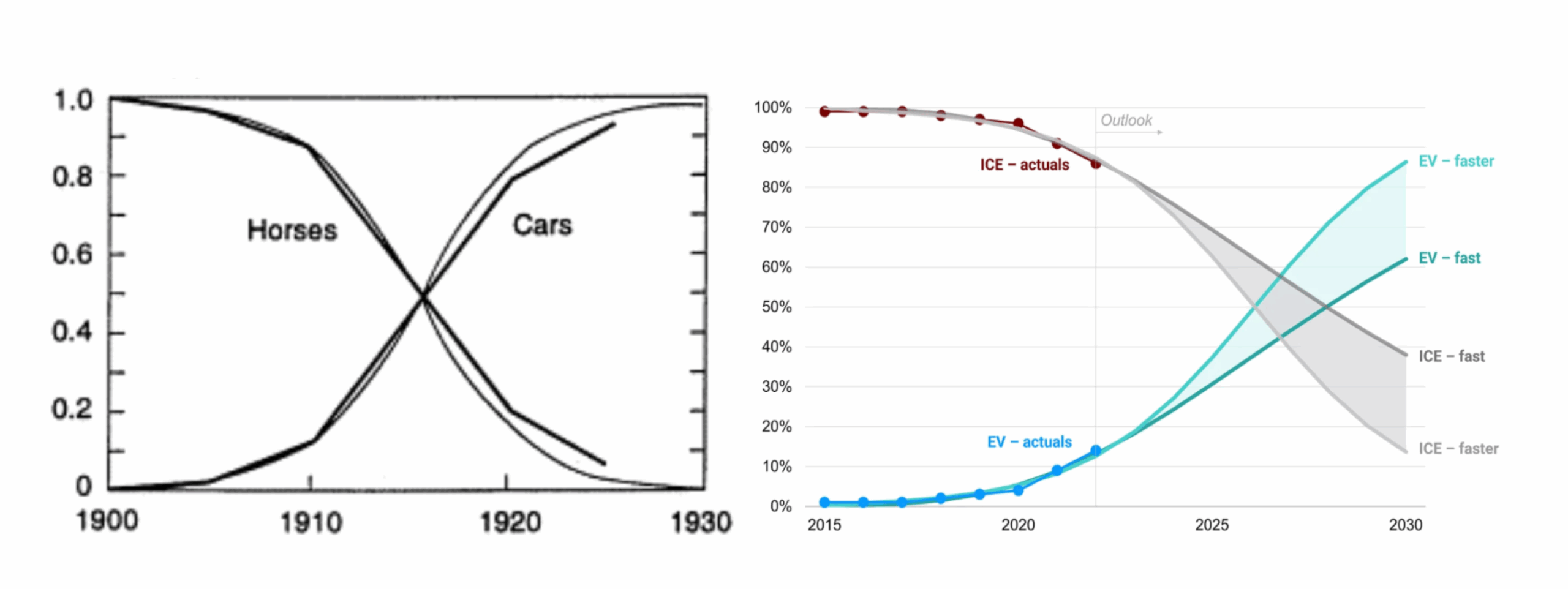
Internal combustion engine (ICE) vehicles did not prevail in becoming the dominant mode of transport through technical superiority alone. They were backed by massive public investment in roads, city planning, zoning and highway expansion funded by fuel taxes.
Meanwhile, they faced few penalties for pollution and externalities, benefitting from implicit subsidies over cleaner alternatives. Standardisation, industrial policy and wartime procurement further entrenched the ICE.
EVs are well-positioned to follow a faster trajectory, as they directly substitute ICE vehicles while being cleaner, cheaper and quieter to run.
Past transitions show that like-for-like replacements – such as black-and-white to colour TVs – tend to diffuse faster than entirely novel products.
Late adopters also benefit from cost reductions and established norms. For example, car ownership took 60 years to diffuse across the US, but just 20 years in parts of Latin America and Japan.
In today’s globalised economy, knowledge, capital and supply chains travel faster still. Our research suggests that the global EV shift could be achieved within decades, not half a century.
Yet without decisive policy, investment and coordination, feedback loops could slow, locking in fossil-fuel dependence.
Our research suggests that further supporting the widespread deployment of EVs hangs on three interlinked actions: supporting adoption; integrating with clean electricity systems; and ensuring sustainability across supply chains and new mobility systems.
Closing the cost gap
EVs have long offered lower running costs than ICE vehicles, but upfront costs – while now cost-competitive in China, parts of Europe and in growing second-hand markets – remain a major barrier to adoption in most regions.
While battery costs have fallen sharply – lithium-ion battery packs fell by 20% in 2024 alone – this has not fully translated into lower retail vehicle prices for consumers.
In China, a 30% fall in battery prices in 2024 translated into a 10% decline in electric SUV prices. However, in Germany, EV retail prices rose slightly in 2024 despite a 20% drop in battery costs.
These discrepancies reflect market structures rather than cost fundamentals. Our report suggests that a competitive EV market, supported by transparent pricing and a strong second-hand sector, can help unlock cost parity in more markets.
Beyond the sale of EVs, government policy around running costs, such as fuel duty, has the potential to disincentivse EV adoption.
For example, New Zealand’s introduction of road-pricing for EVs contributed to a collapse in registrations from nearly 19% of sales in December 2023 to around 4% in January 2024.
EV-specific fees have also been introduced in a number of US states. Last month, the UK also announced a per-mile charge for EVs – but not ICEs – from 2028.
Addressing the loss of fuel-duty revenue as EVs replace ICE vehicles is a headache for any government seeking to electrify mobility.
However, to avoid slowing diffusion, new revenues could be used to build out new charging infrastructure, just as road-building was funded as the ICE vehicle was scaling up.
While subsidies to support upfront costs can help enable EV adoption, the best approach to encouraging uptake is likely to shift once the sector moves into a phase of mass diffusion.
Targeted support, alongside innovative financing models to broaden access, from blended finance to pay-as-you-drive schemes, could play a greater role in ensuring lower-income drivers and second-hand buyers are not left behind.
Mandates as engines of scale
Zero-emission vehicle (ZEV) mandates and ICE phase-out deadlines can reduce costs more effectively than alternatives by guaranteeing market scale, our research finds, reducing uncertainty for automakers and pushing learning rates forward through faster production.
California’s ZEV mandate was one of the first in the 1990s, a policy that has since been adopted by ten other US states and the UK.
China’s NEV quota system has produced the world’s fastest-growing EV market, while, in Norway, clear targets and consistent incentives mean EVs now account for nearly all of new car sales. These “technology-forcing” policies have proved highly effective.
Analyses consistently show that the long-run societal benefits of sales mandates for EVs far outweigh their compliance costs.
For example, the UK’s ZEV mandate has an estimated social net present value of £39bn, according to the government, driven largely by emissions reductions and lower running costs for consumers.
Benefits can also extend beyond national borders. For example, California’s “advanced clean cars II” regulations – adopted by a number of US states and an influence on other countries – have been instrumental in compelling US automakers to develop and commercialise EVs, which can, in turn, trigger innovation and scale to reduce costs worldwide.
Research suggests that, where possible, combining mandates and incentives creates further synergies: mandates alleviate supply-side constraints, making subsidies more effective on the demand side.
Public charging: a critical bottleneck
Public charging is one of the most significant impediments to EV adoption today.
Whereas EVs charged at home are substantially cheaper to run than ICE vehicles, higher public charging costs can erase this benefit – in the UK, this can be up to times the home equivalent.
While most homes in the UK, for example, do have access to off-street parking, there are large swathes of low-income and urban households without access to private driveways. For these households, a lack of cheap public charging has been described as a de facto “pavement tax”, which is disincentivising EV adoption and resulting in an inequitable transition.
Our research shows that a dual-track charging strategy could help resolve the situation. Expanding access to private charging – through cross-pavement cabling, “right-to-charge” legislation for renters and planning mandates for new developments could be combined with strategic investment in public charging, to overcome the “chicken-and-egg” problem for investors uncertain about future EV demand.
Meanwhile, “smart charging” in public settings – where EV demand is matched with cheaper electricity supply – can also help close the affordability gap, by delivering cheap off-peak charging that is already available to those charging at home.
The Centre for Net Zero’s research shows that drivers respond to dynamic pricing outside of the convenience of their homes, which reduces EV running costs below those of petrol cars.
The figure below shows that, while the level of discount being offered had the strongest impact, lower-income areas showed the largest behavioural response, indicating that they may stand to gain the most from a rollout of such incentives.

Our research suggests that policymakers could encourage this type of commercial offering by creating electricity markets with strong price signals and mandating that these prices are transparent to consumers.
Integrating with clean electricity grids
Electrification is central to decarbonising the world’s economies, meaning that sufficient capacity on electricity networks is becoming a key focus.
For the rollout of EVs, pressure will be felt most on low-voltage “distribution” networks, where charging is dispersed and tends to follow existing peaks and troughs in domestic demand.
Rather than responding to this challenge by just building out the grid – with the corresponding economic and political implications – making smart charging the norm could help mitigate pressure on the network.
Evidence from the Centre for Net Zero’s trials shows that AI-managed charging can shift EV demand off-peak, reducing residential peak load by 42%, as shown in the chart below.
Additionally, the amount of time when EVs are plugged in but not moving is often substantial, giving networks hours each day in which they can shift charging, targeting periods of low demand or high renewable output.
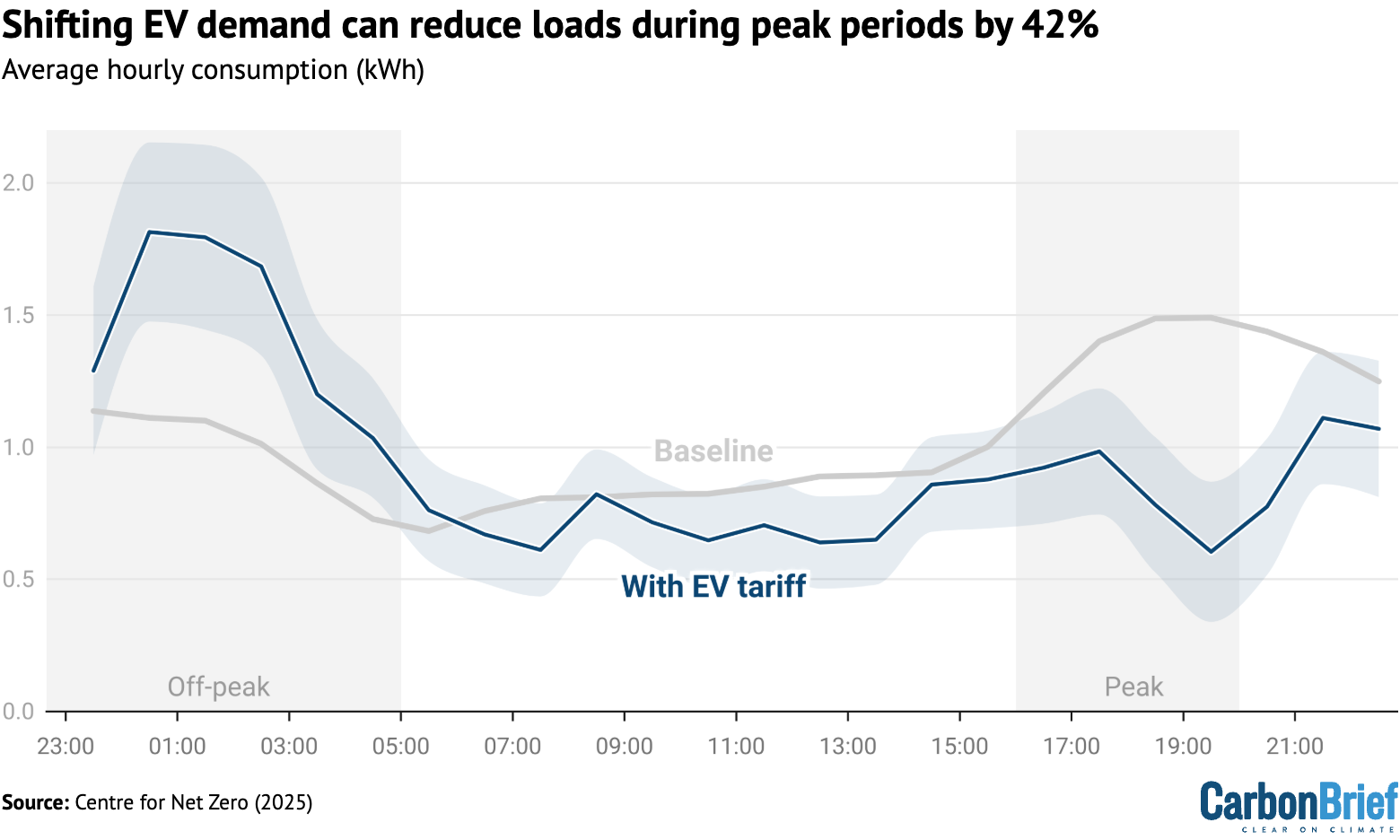
The system value of this flexible charging is significant. In the UK, managed charging could absorb 15 terrawatt hours (TWh) of renewable electricity that would otherwise be curtailed by 2030 – equivalent to Slovenia’s entire annual consumption.
For these benefits to be realised, our research suggests that global policymakers may need to mandate interoperability across vehicles, chargers and platforms, introduce dynamic network charges that reflect local grid stress and support AI-enabled automation.
Bi-directional charging – which allows EVs to export electricity to the grid, becoming decentralised, mobile storage units – remains underexploited. This could allow EVs to contribute to the capacity of the grid, helping with frequency and providing voltage support at both local and system levels.
The nascency of such vehicle-to-grid (V2G) technology means that penetration is currently limited, but there are some markets that are further ahead.
For example, Utrecht is an early leader in real-world V2G deployment in a context of significant grid congestion, while Japan is exploring the use of V2G for system resilience, providing backup power during outages. China is also exploring V2G systems.
Our research shows that if just 25% of vehicles across six major European nations had V2G functionality, then the theoretical total capacity of the connected vehicles would exceed each of those country’s fossil-fuel power fleet.
Mandating V2G readiness at new chargepoints, aligning the value of exports with the value to the system and allowing aggregators to pool capacity from multiple EVs, could all help take V2G from theory to reality.
A sustainable EV system
It is important to note that electrification alone does not guarantee sustainability.
According to Rocky Mountain Institute (RMI) analysis, the total weight of ore needed to electrify the world’s road transport system is around 1,410mtonnes (Mt). This is 40% less than the 2,150Mt of oil extracted every year to fuel a combustion-based system. EVs concentrate resource use upfront, rather than locking in fossil-fuel extraction.
Moreover, several strategies can reduce reliance on virgin minerals, including recycling, new chemistries and improved efficiency.
Recycling, in particular, is progressing rapidly. Some 90% of lithium-ion batteries could now be recycled in some regions, according to RMI research. Under an accelerated scenario, nearly all demand could be met through recycling before 2050.
Finally, while our report focuses largely on EVs, it is important to highlight that they are not a “silver bullet” for decarbonising mobility.
Cities such as Seoul and New York have demonstrated that micromobility, public transport and street redesign can cut congestion, improve health and reduce the number of overall vehicles required.
Better system design reduces mineral demand, lowers network strain and broadens access.
The ‘decision decade’ ahead
Policy decisions made today will determine whether EVs accelerate into exponential growth or stall.
Our research suggests that governments intent on capturing the economic and environmental dividends of electrified mobility are likely to need coherent, cross-cutting policy frameworks that push the market up the steep climb of the EV S-curve.
The post Guest post: How to steer EVs towards the road of ‘mass adoption’ appeared first on Carbon Brief.
Guest post: How to steer EVs towards the road of ‘mass adoption’
-
Climate Change4 months ago
Guest post: Why China is still building new coal – and when it might stop
-
Greenhouse Gases4 months ago
Guest post: Why China is still building new coal – and when it might stop
-
Climate Change2 years ago
Spanish-language misinformation on renewable energy spreads online, report shows
-

 Greenhouse Gases2 years ago
Greenhouse Gases2 years ago嘉宾来稿:满足中国增长的用电需求 光伏加储能“比新建煤电更实惠”
-
Climate Change Videos2 years ago
The toxic gas flares fuelling Nigeria’s climate change – BBC News
-

 Climate Change2 years ago
Climate Change2 years ago嘉宾来稿:满足中国增长的用电需求 光伏加储能“比新建煤电更实惠”
-

 Carbon Footprint2 years ago
Carbon Footprint2 years agoUS SEC’s Climate Disclosure Rules Spur Renewed Interest in Carbon Credits
-
Climate Change2 years ago
Why airlines are perfect targets for anti-greenwashing legal action



